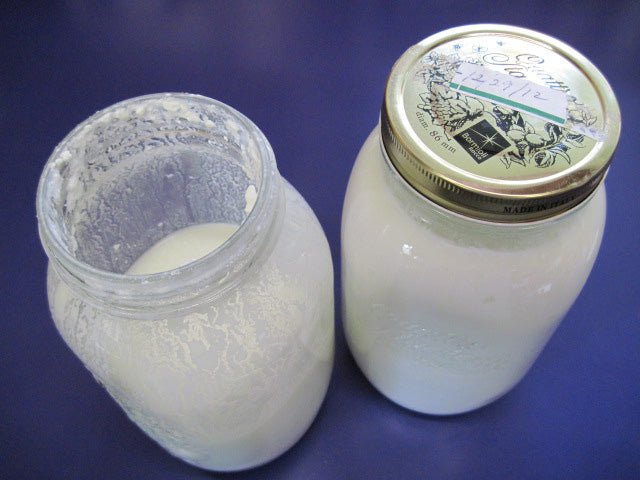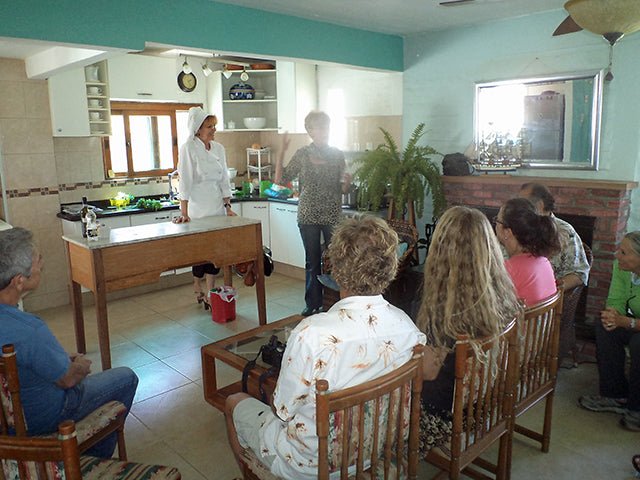 |
| My kefir made with unpasteurized goat’s milk |
WARNING – This is a political post. I don’t do many of them, but occasionally I like to exercise my right to free speech. (Out of 347 posts, this is only the third one, so please bear with me!)
Several years ago, our owner, Ricki Carroll, (AKA-The Cheese Queen) made the courageous decision for New England Cheesemaking Supply Company to support the real milk movement, even though many of our customers do not. The reason I say this was courageous is because there is no benefit to our company in doing this. We just think it’s the right (and healthy) thing to do.
To be clear – we support the licensing and regulation of raw milk production. Listeria seldom comes from the milk itself, but from the unsafe ways it is handled and treated. There have been many more cases of listeria from pasteurized milk than from unpasteurized. (And, of course there are 10 times more cases of listeria from deli meats than from any type of dairy product.)
In our state, Massachusetts, we can buy real milk at farms which are licensed by the state to sell it. These farms are closely monitored, with inspectors visiting regularly to take bacterial counts. (At least one of the farms I go to has bacterial counts which are only a small fraction of the upper limit allowed for safety.)
However, if you belong to a CSA, your real milk cannot legally be delivered with your other food products. This is, of course, extremely inconvenient for parents who are trying to feed their families fresh and healthy food.
There are now bills in 3 states to enable CSA delivery of raw milk. If you would like to express support, it’s very easy. Click on the links at the end of the article below and send a note to your state Representatives.
If you don’t agree with us in supporting these bills or the real milk movement in general, we encourage you to exercise your right to free speech in the Comment section at the end of this post. (And please know that even if you disagree with us on this issue, we still value you as a member of our extended cheese making family!)
Here’s a great article from the Alliance for Natural Health, submitted by Mary Sonnekson of Athens, Vermont:
Healthful Artisanal Cheese Under Attack Again
Alliance for Natural Health
April 16, 2013
FDA simply ignores the lack of a single documented illness in twenty-three years. Action Alert!
Cheese, particularly real cheese, gets a bad rap. The American Heart Association makes “heart-healthy suggestions” to eat cheese with five or fewer grams of fat per ounce, and light or fat-free cheese products. The American Diabetes Association recommends low-fat cheese recipes – even though they usually contain more sugar! And the Physicians Committee for Responsible Medicine put up a series of billboards showing fat folks with the captions “Your Abs on Cheese” and “Your Thighs on Cheese.”
This is all nonsense. Cheese is actually good for you— especially when it’s made correctly, as is done in Europe by introducing bacteria at the right time and following a careful process. Artisanal cheese is hand-made from milk that comes from a single source (local whenever possible), and its creation focuses on the quality of its raw ingredients and the health of its animals. People are generally willing to pay higher prices because of its superior taste and health benefits. Cheese is the best source of vitamin K2, which the body needs (together with vitamin D) to process calcium correctly.
Unfortunately, artisanal cheese is not widely available in the US. There are some raw-milk artisanal cheese producers in some states, though not many. Several years ago, the FDA shut down the importation of most fine cheeses from Europe. Only a few larger companies—mainly offering pasteurized cheeses—are still allowed to import to the US, though as Cathy Goldsmith of Berkeley’s Cheese Board Collective points out, “The pasteurized versions are just not very good. They don’t ripen in the same way. They get flat and bitter as opposed to gooey and rich and multilayered in flavor,” and sales of pasteurized imported cheeses have dropped.
Of course, the industrialized, pasteurized, often tasteless cheeses are not only protected from competition; they also get tremendous economic support directly from the government. The government buys it and distributes much of it to school lunches where it is used mainly in pizza. You know, the same pizza which for the government counts as a vegetable because it has some tomato sauce. The USDA even has a marketing arm called Dairy Management that actively pushes the sale of cheese and milk.
How did we get so obsessed with pasteurization anyway? After World War II, retail milk’s competition was based on how much cream your milk had—the more the better—which was clearly visible because of “the cream line.” But this made the cheaper, less rich milk harder to sell. So the dairy industry started homogenizing the milk to do away with the cream line. That catch is that once milk is homogenized, if there is no further processing, it will go rancid in a matter of hours, which didn’t happen as quickly when milk was kept in its natural state. So pasteurization was mandated, first by states and then federally.
The FDA wants simple solutions and does not want to be blamed for food poisoning. So it likes large scale industrial solutions like pasteurization, especially ultra-pasteurization, and food irradiation (“nuking”). It has been alarmed about listeria in cheese for some time. The initial charge, and especially the attack on French cheese, came at the same time the French were refusing to support the invasion of Iraq. That is when French raw cheese was first banned and then only a few large producers were allowed to send it here.
Now the FDA, in conjunction with Health Canada, has just issued a joint risk assessment that claims consumers are “up to 160 times more likely” to contract a listeria infection from soft-ripened cheese made from raw milk compared to the same cheese made with pasteurized milk. Listeria monocytogenes has some of the highest fatality and hospitalization rates among pathogenic bacteria.
In the US, the FDA estimates that there is one case of listeriosis linked to raw-milk cheese for every 55 million servings eaten. Except that this estimate is not based on any direct evidence—it’s a mathematical probability only. The report is actually saying that if 55 million people eat raw-milk cheese (and with as little raw-milk cheese as is being sold in this country, the idea that 55 million of us are eating unpasteurized cheese is patently absurd), it is a mathematical probability that one lone individual will get sick from it.
In fact, it’s the lack of damning evidence that is so striking. Between 1986 and 2008, the report could not account for one single documented illness in the US from listeriosis due to tainted brie or camembert (soft cheeses). The researchers were only able to document twenty occurrences of illness from listeria in all cheeses from all kinds of milk worldwide over the same twenty-three-year period—less than one per year—and, according to the report, half of these illnesses involved cheese made from pasteurized milk! Compare that to the frequency of other foodborne illnesses (more than 1,000 outbreaks, resulting in between 15,000 and 30,000 illnesses, from all foods each year in the US), and raw cheese has a demonstrably sterling record of safety.
Listeria usually comes from the cheese-making environment, not from the milk itself. The few problems that have occurred were almost all from unlicensed producers. On page 17 of the report, they show four outbreaks of listeriosis from soft cheese—but all four were from homemade raw milk queso fresco (nicknamed “bathtub cheese”) which was not aged the required 60 days. In other words, the only incidents have been from cheese that was already illegal in the US.
While the FDA has a zero tolerance policy for listeria, which effectively crushes raw dairy production, Europe takes a different approach. They have tolerance limits with strict quality control measures in place.
The FDA is making its draft risk assessment available for public comment.
The Weston A. Price Foundation, in its formal comments to the FDA, recommends that FDA rules on dairy take into account processes for raw cheese making, and that it should be sensitive to the size and scale of the operation. Unfortunately this runs contrary to everything the FDA seems to believe in.
Of course, cheese is not the only story here. Weston Price as a good deal to say about the health value of real butter—butter made from raw milk—which is naturally high in vitamin A, supports the immune system, is good for preventing arthritis and osteoporosis, and helps the thyroid gland and the gastrointestinal system. Butter generally sells for hardly more than cream, even though it is made from cream and takes a good deal more work to produce—which means there’s no price incentive for artisans to produce raw milk butters. Producers are further discouraged from making raw butter because the FDA makes it so difficult for them.
Action Alert! There are bills pending in three states—Hawaii, Indiana, and Massachusetts—that deal with the sale of raw milk and milk products directly to the consumer. Please contact your state legislators and let them know you support raw milk and artisanal cheeses and butters!
Hawaii Action Alert!
Indiana Action Alert!
Massachusetts Action Alert!















































































































































